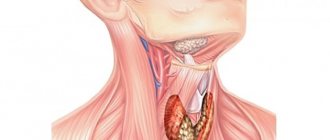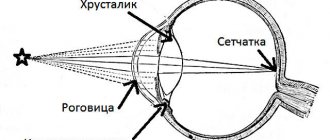Allergic laryngeal edema is a pathological condition characterized by inflammation of the mucous tissues of the larynx and narrowing of its lumen (stenosis). It occurs due to the body’s contact with factors hostile to it – allergens.
Author:
- Sadykhov Rahim Agalarovich
ENT pathology expert
2.39 (Votes: 36)
Allergic laryngeal edema is a pathological condition characterized by inflammation of the mucous tissues of the larynx and narrowing of its lumen (stenosis). It occurs due to the body’s contact with factors hostile to it – allergens, which cause a negative immune reaction. The main danger of edema is depression of respiratory function. As the lumen of the larynx narrows, breathing becomes difficult, which provokes oxygen deficiency, which is life-threatening.
Causes of swelling
Laryngeal edema occurs as a response of the body to an allergen irritant. This reaction is individual - under the same conditions, the same stimulus can cause a serious condition in one person, but not affect another in any way. It depends on the characteristics of the immune system.
Allergens may be the following:
- medications, especially when administered intravenously and intramuscularly;
- pet hair;
- insect bites;
- fungi, mold;
- food (often nuts, milk, eggs, fish, some vegetables, fruits);
- chemical substances;
- dust, pollen.
During the first few years of a child’s life, the immune system has not yet been formed, so even the simplest diseases manifest themselves extremely acutely in the child, causing him and his parents a lot of inconvenience. One such disease is laryngospasm .
Laryngospasm is usually understood as sudden attacks of convulsively contracting muscles of the larynx. There is a rapid narrowing of the glottis until it is completely blocked. Similar attacks can occur in children from three months to two or three years. Such spasms can be repeated several times a day and usually appear during the daytime. In adults, such spasms are observed extremely rarely, and their appearance can be facilitated by the entry of foreign bodies into the oral cavity.
Quite often, such a sharp contraction of the muscles during laryngospasm occurs when the baby coughs and cries. The baby may break out in sweat and have a weak pulse. In this case, shallow or isolated respiratory movements are noted, after which the frequency and depth of breathing are invariably restored. After such a spasm, the child may fall asleep for a short time and calm down.
Causes of laryngospasm
It should be said that there can be many reasons for the appearance of such spasms. This is an abnormal metabolism, disruption of the muscles and nervous system. The child has increased nervous excitability, which leads to uncontrolled muscle contractions. It has been established that one of the reasons for the appearance of laryngospasm may be a lack of vitamin D and calcium in the body. That is why close attention should be paid to the quality of nutrition, which has a positive effect on the overall metabolism and the presence in the child’s body of all the microelements he needs.
In some cases, increased activity and nervous excitability of the child can provoke laryngospasm. For example, due to severe stress and fear, laughter and intense crying, attacks of laryngospasm may occur.
Treatment methods for this disease
It must be said that laryngospasm is not actually a disease, but refers to acute attacks, therefore, to eliminate it, it is necessary to treat the causes that lead to involuntary contraction of the muscles of the larynx. It is often difficult to independently determine the reason why such laryngospasm occurs. That is why if you notice signs of such a disease in your baby, you should consult a doctor. An ENT specialist or pediatrician, after conducting appropriate research, will be able to determine the cause of the attacks. An experienced specialist will also select the correct treatment, which will be the key to reducing the number of such attacks, and soon laryngospasm will completely disappear.
Parents should be told that when such spasms occur, distraction therapy shows excellent results. To relieve a spasm in a child aged several years, you can ask him to hold his breath. Warm baths are a great help for severe attacks. In especially severe cases, when there is a threat to the child’s life, intubation and tracheotomy are performed, which allows the child to restore breathing.
To treat laryngospasm, restorative therapy, hardening are carried out, and vitamin complexes with calcium and vitamin D are prescribed. As the child grows, the frequency of such spasms decreases significantly, and soon the problem completely disappears.
Types of allergic laryngeal edema
There are acute and chronic allergic edema.
Acute allergic edema
In this case, you must call emergency assistance. Difficulty breathing is obvious and sudden, the condition is rapidly deteriorating. A person breathes intermittently and frequently; the muscles of the shoulders, head and back are involved in breathing, the supraclavicular fossae are sunken, and the intercostal spaces are drawn in. The skin turns pale, blue, the pulse increases, and the patient may begin to panic. In the absence of medical assistance, the lumen of the larynx closes completely, which causes asphyxia and death.
Before the arrival of medical workers, those close to the patient should be advised by telephone what to do. Emergency tips for breathing problems:
- interrupt the person’s contact with the substance that caused such a reaction (if this can be determined);
- in case of food poisoning, rinse the stomach;
- free a person from being squeezed by clothing;
- provide a flow of fresh air;
- give an antihistamine.
Chronic allergic edema
In this case, discomfort in the throat and breathing problems occur periodically, without getting worse, but giving the person very unpleasant sensations. This condition is a consequence of certain diseases or systematic contact with an allergen (for example, mold or animal hair in the house). Its symptoms are as follows:
- swelling and redness of the tonsils, uvula and palate;
- difficulty inhaling more than exhaling;
- rapid breathing;
- dyspnea;
- sensation of a foreign body in the throat;
- inability to exercise due to worsening breathing problems.
If you have these symptoms, be sure to consult an otolaryngologist to cure the underlying disease or remove the allergen from your environment.
Chronic allergic edema of the larynx is dangerous because it can sharply and suddenly develop into Quincke's edema - when the increase in clinical manifestations occurs within a few minutes. Quincke's edema is characterized by severe swelling of the neck and face and can spread to the mucous membrane of the larynx, causing severe stenosis. If signs of Quincke's edema appear, you should urgently call an ambulance.
In cases of chronic allergies, the person is usually aware of their condition and should always keep antihistamines on hand to stop the progression of the condition. Such drugs are prescribed by the doctor individually - there are different types of antihistamines, and it is important to choose the ones that suit you.
Laryngospasm. Spasm of the larynx. Help with laryngospasm.
Laryngospasm is a sudden involuntary contraction of the muscles of the larynx. Causes partial or complete closure of the glottis and occurs with inspiratory dyspnea (difficulty breathing).
Sometimes it is combined with tracheospasm, when the smooth muscles of the posterior membranous part of the trachea simultaneously contract.
This condition can occur in adults, but most often it affects children aged 3 months to 2 years, especially if there are risk factors. This is due to the fact that precisely at the age of up to 2 years, the physiological lumen of the glottis is very small, and the nervous system is too labile and unstable, which can easily provoke a sudden attack of laryngospasm. Attacks of laryngospasm can last from a few seconds to 1-2 minutes, and occur several times a day.
Etiology of laryngospasm
The reason for this pathological condition is the increased reflex excitability of the neuromuscular apparatus of the larynx. During an attack, the aryepiglottic ligaments (two sheets of mucous membrane, separated by connective tissue, are located at the entrance to the larynx) are brought to the midline, the vocal cords are tightly closed, the arytenoid cartilages (paired cartilages to which the vocal cords are attached) are brought together and everted. Therefore, after a noisy inhalation, breathing first becomes shallow, and then may stop altogether, since air cannot pass through. The mucous membrane of the larynx does not change in any way.
Causes of laryngospasm in children:
• lack of calcium in the body;
• deterioration of the body's reactivity;
• birth injury;
• metabolic disorders;
• presence of diseases: chorea, spasmophilia, bronchopneumonia, rickets, etc.;
• pathological changes in the organs of the respiratory system – trachea, lungs, pharynx;
• instillation of various active substances (for example, adrenaline) into the nasal passages.
Laryngospasm in children occurs during:
• severe cough;
• hysterical crying;
• laughter;
• fright.
Etiology of laryngospasm in adults:
• the effect of various medications used to treat the laryngeal mucosa;
• infringement of a benign tumor;
• inhalation of air that contains a certain amount of allergens (dust, pollen, various aromatic substances, etc.);
• swelling of the surface of the larynx;
• inflammation of the surface of the larynx;
• irritation of the recurrent laryngeal and vagus nerves (for example, due to an aneurysm, stressful situations that are accompanied by severe anxiety).
!!! A characteristic feature of laryngospasm is its unexpected appearance.
Symptoms of laryngospasm:
• noisy, whistling and difficult breathing develops;
• unable to clear throat;
• the skin turns pale, a bluish tint appears, and the nasolabial triangle is clearly visible;
• the muscles of the face, neck, and abdomen are tense, the mouth is open, the head is thrown back;
• profuse sweat appears;
• the pulse is hard to palpate, and the breathing process may temporarily stop;
• the reaction of the pupils to light is absent or weakened.
Symptoms of severe laryngospasm:
• loss of consciousness;
• depression of cardiac activity;
• limb spasms;
• foam at the mouth;
• involuntary urination, defecation.
!!! In case of a prolonged attack, if help is not provided immediately, death from asphyxia will occur.
In adults, hysterical laryngospasm is combined with convulsions of the pharynx, esophagus and limbs. As a rule, the attack quickly stops on its own. This attack resembles an epileptic seizure. In mild cases, there is a short-term narrowing of the glottis, a prolonged wheezing breath, pale or blue discoloration of the face, short shortness of breath, and sobbing.
Diagnosis of laryngospasm
The diagnosis of laryngospasm is made based on the clinical picture of the attack and the patient’s complaints.
First aid for laryngospasm
With laryngospasm, it is not the attack itself that needs to be treated, but the cause of its occurrence. To avoid complications, you should call a doctor or an ambulance at the first sign of laryngospasm. Until the doctor arrives, adults should do the following:
1. During an attack, the patient should be reassured, a calm environment should be created, and fresh air should be provided (unbutton the collar, bring it to the window).
2. Reflex methods for relieving spasms: splash cold water on the face and body, or irritate the nasal mucosa with a cotton swab, or blow into the nose, apply ammonia or press on the root of the tongue with a spatula.
3. In the event of a severe attack, the child should be laid on a flat, hard surface, since cardiac arrest is possible, requiring resuscitation measures.
4. It is imperative to administer calcium gluconate intravenously at a dosage of 1 ml per year of life, since the cause of spasmophilia is hypocalcemia. In especially severe cases, the world's only depolarizing muscle relaxant, succinylcholine, is used.
5. If there is no effect, perform intubation or tracheotomy to ensure airway patency.
6. In case of cardiac arrest, resuscitation measures are carried out: indirect cardiac massage.
7. Considering that hypoxia develops as a result of laryngospasm, oxygen therapy must be administered after breathing is restored.
Prevention of laryngospasm
Hardening procedures and restorative treatment are prescribed. Often prescribed are vitamin D, medications containing calcium, ultraviolet irradiation, consumption of dairy and plant foods, long walks in different places (forest, park, embankment).
Relaxation activities for children are recommended. This could be some special games, massage, drawing. The main rule: the child cannot be forced to do this, as this will no longer be relaxing. When choosing a distraction activity, it is very important to observe what the child likes and what calms him down. A balanced diet and vitamin intake can also contribute to a speedy recovery.
Only by following simple recommendations and regularly being examined by an ENT doctor can you get rid of laryngeal muscle spasms forever.
Prognosis for laryngospasm
With timely and adequate treatment, the prognosis is favorable. It is also worth noting the fact that often, as the child grows up, laryngospasm completely disappears and treatment is no longer required.
So, as you understand, laryngospasm is a life-threatening condition, therefore it is very important to recognize it as early as possible and also quickly provide first aid and call a doctor.
Diagnosis and treatment
At the appointment, the doctor collects anamnesis, examines and palpates the larynx. If necessary, bronchoscopy and laryngoscopy procedures, X-rays, and computed tomography are performed.
Allergic swelling of the larynx is treated with medication or surgery. Medicines include antihistamines, which suppress the action of histamine, and glucocorticosteroids, which block the inflammatory response and swelling and suppress the immunological response to the allergen. Surgical intervention is a tracheostomy, an emergency measure when a person is at immediate risk of suffocation - inserting a breathing tube into the trachea through a small incision in the throat.
Prevention
As preventative measures, as well as after an attack, it is recommended:
- strengthen immunity;
- perform moderate physical activity;
- use halotherapy and climatotherapy (stay at sea and in the mountains);
- use air purifiers;
- adhere to a diet excluding highly allergenic foods and products containing preservatives and chemical additives.
If you are concerned about breathing problems of any kind, we are always ready to provide assistance, make the correct diagnosis and begin treatment immediately. Call and make an appointment at the Ear, Nose and Throat Clinic!






